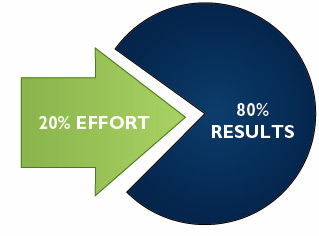A couple of months ago, in a respected marketing Webzine, there appeared a case study detailing a software company that had gone to impressive lengths to make the most of their investment in marketing automation. The lead nurturing program they implemented included 40+ (yes, forty) separate and distinct tracks of emails, tailored to different audience segments, product interests, and stages in the lead lifecycle.
That is, by most standards, a program of gordian complexity, and the effort and strategic thinking that went into its design should be lauded. Yet, for me, it raises a concern – namely that stories in the marketing press like this one may be raising the bar for lead nurturing too high, setting too high a standard, and in the process making lead nurturing seem more complex, and more daunting to the uninitiated than it really should be.
The truth is – it’s not required to develop anywhere near 40 emails, never mind 40 separate tracks, to build a highly effective lead nurturing program. In fact, I’d like to propose a rule – let’s call it the 80/20 Rule of Lead Nurturing – as follows:
80% of the benefit of lead nurturing is achieved by the first 20% of effort.
 That is, the vast majority of your return from a lead nurturing program is achieved by addressing the very basic business problems that lead nurturing is designed to solve.
That is, the vast majority of your return from a lead nurturing program is achieved by addressing the very basic business problems that lead nurturing is designed to solve.
Yes, you can tailor emails to fit every possible unique combination of demographic and behavioral criteria. You can respond to every possible whim of a Web visitor with an email specifically crafted to nudge that person down a pre-determined sales path. You can take into account product interest, search query, age, company size, time of day, and a million other variables and version your lead nurturing strategy accordingly. But is all that necessary?
Not really.
One consequence of a hyper-competitive marketing automation marketplace is a kind of one-upmanship for promoting ways to utilize the technology to its maximum advantage. 40 email tracks may help you squeeze every last ounce of benefit from your marketing automation system, but does it deliver 10 times the benefit of a program with only say, 4 tracks? I doubt it.
In the B2B tech market where we do the majority of our work, most of the lead management programs we help design address relatively few, very common objectives, namely:
* automating follow-up communication with leads too numerous to be promptly addressed exclusively through direct sales; and
* nurturing and cultivating contacts over time so those contacts remember the client’s brand when the need arises.
With a marketing automation solution in place, you could design a program to do these two things alone: i.e. automated lead follow-up and systematic lead nurturing, and little else, and achieve significant results in sales productivity, lead qualification, and demand generation ROI. That’s not to say lead nurturing success is automatic: adhering to best practices in how many emails you send and how often, the tone and language of those emails, the offer strategy, the design of your landing page, and a dozen other variables are all critically important.
But 40 emails? Not so much.

Excellent. Sensible advice in a noisy space.
Howard,
A common sense approach. Your years of experience are showing. It’s what we used to call a ‘pissing contest’. My marketing automation campaign is bigger (and more complex) than yours. It’s nice to hear a voice of reason.
Bob
We practice the less is more approach for our clients too. We typically do tracks by industry, where you simply note a value prop for the industry in the email text and the link or attachment is as relevant to that industry as possible.
Thanks to everyone for their comments. I’m reminded of a conversation a few months back with a potential client who asked: “What’s the most complex lead nurturing program you’ve ever created?” As if complexity were the measure of effectiveness. (We didn’t get the business.)
Great post Howard. Your post and your last comment reminds me of a client – very similar to the one you talked to – who stated that one of the evaluation criteria of our marketing automation proposal would be “seeing how sophisticated your lead scoring model is.” I believe the arms-race among the major MA software vendors has (in some cases) lead buyers to a place where complexity is valued on par with effectiveness. But the relative paucity of successful marketing automation deployments (versus sales volume) shows the limitations of this approach. If clients can’t deploy the solution, what good is sophistication?